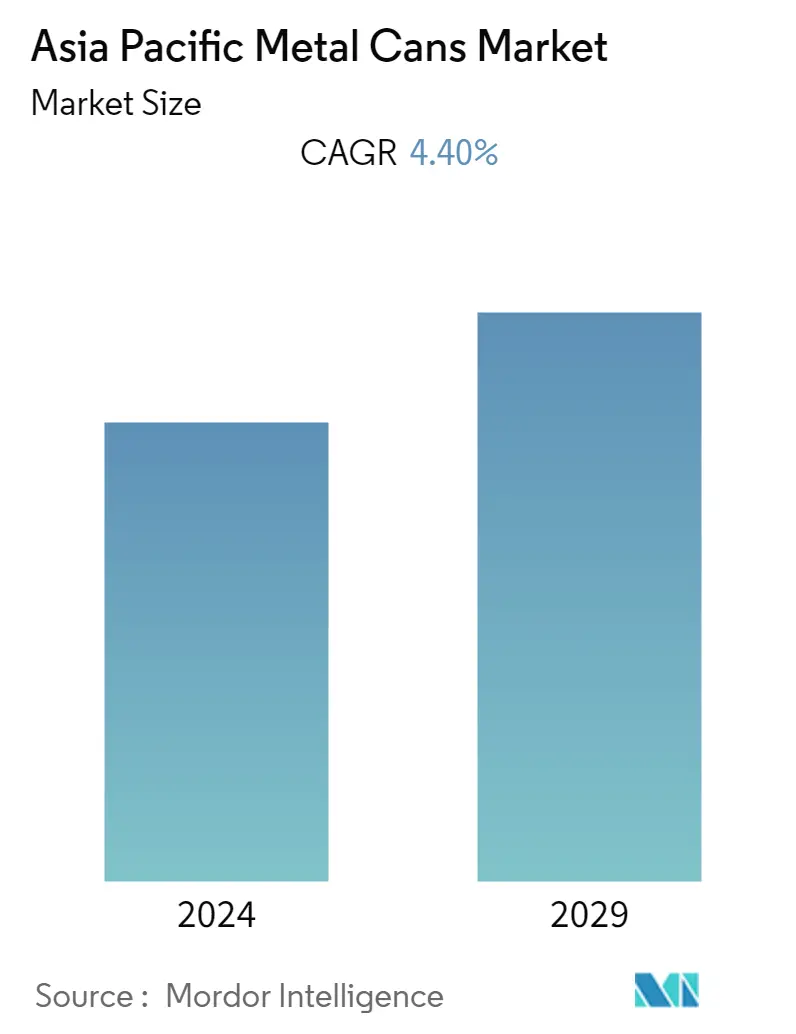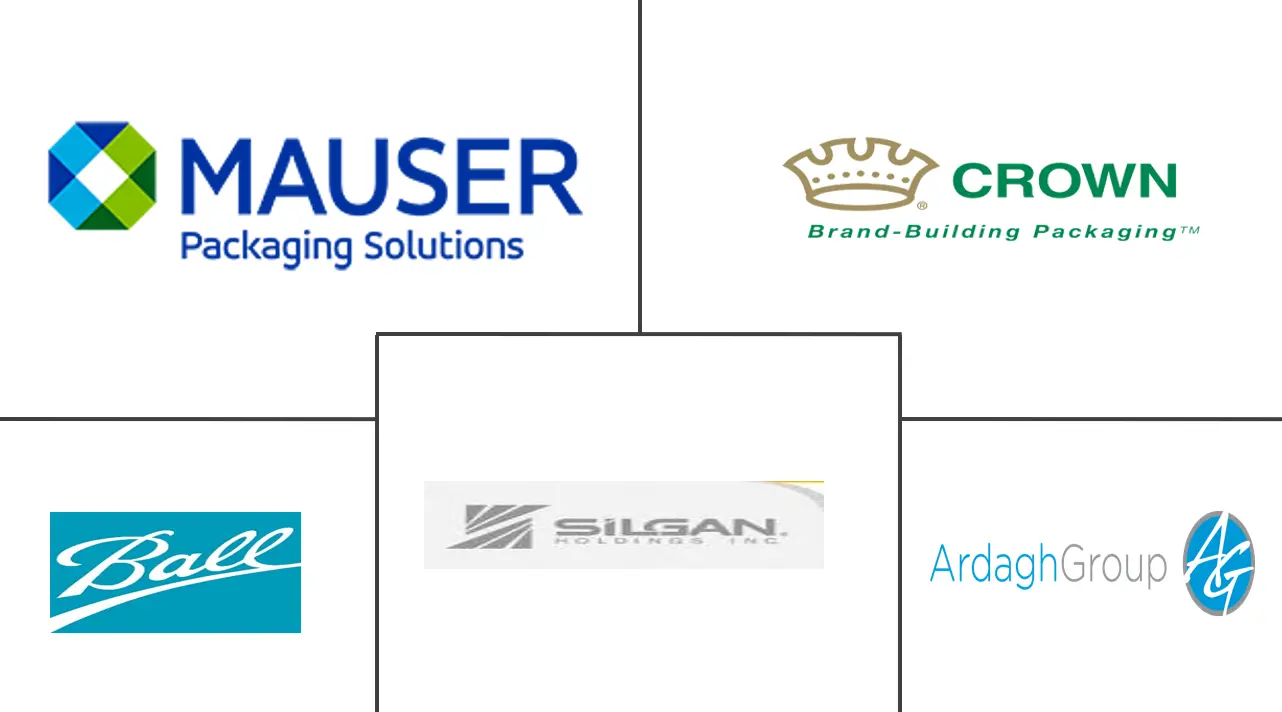Market Size of Asia Pacific Metal Cans Industry

| Study Period | 2019 - 2029 |
| Base Year For Estimation | 2023 |
| Forecast Data Period | 2024 - 2029 |
| Historical Data Period | 2019 - 2022 |
| CAGR | 4.40 % |
| Market Concentration | Medium |
Major Players
*Disclaimer: Major Players sorted in no particular order |
APAC Metal Cans Market Analysis
The APAC Metal Cans Market is expected to register a CAGR of 4.4% for the forecast period 2021-2026. The food and beverage industry, with a major share in the metal, can provide packaging market, is witnessing huge demand amidst the COVID-19 pandemic, as the industry falls under the essential commodity. The lockdown enforced across the world due to the COVID-19 pandemic has bought a significant change in human consumption habits. There has been an increasing demand for packaged food products, meat, vegetables, and fruits, among others.
- The excellent preservative properties and structural integrity of the metal cans, offering higher shelf life, have resulted in the high usage of metal cans in the food packaging industry across Asia. Packaged and convenience food has become a staple diet for many consumers, owing to their hectic lifestyles and work schedules.
- Consumer trends, such as a preference for small-size and multi-pack packaging formats, are supporting the volume growth of the global metal cans market.
- Increasing demand for mini-cans has been observed, especially in the Asia-Pacific markets, such as India, China, and Japan. Therefore, most of the beverage companies in the region are offering mini-cans, which generally contain smaller volumes of products and cost less than the traditional canned products.
- Further, Asian trends are mixed with Southeast Asia's growth. Multiple manufacturers from China and Japan have expanded their footprint in the region. For instance, Showa Aluminum Can Corporation, via its Project 2020+, has focused on the growth-acceleration of its business in the medium term by targeting Southeast Asia.
- Then, as of October 2020, multiple large steel projects located in Southeast Asia were underpinned by Chinese investment. At the same time of the year, Southeast Asia reportedly gained attention as more food companies shifted away from plastic containers for more recyclable cans. UACJ Corporation, a Tokyo-based company, is expected to boost the output capacity of aluminum sheets at its Southeast Asian plants by 2021.
- Furthermore, numerous innovations pertaining to manufacturing procedures, shapes, sizes, and smart packaging, are helping the manufacturers of metal cans to keep up with the current market trends. Clean surfaces that provide a wide range of multi-stage printing and labeling solutions are attracting many marketing innovations.
- For example, Hindustan Tin Works Ltd, based out of India, offers its general line cans that are made out often and not only offer the highest barrier properties from oxygen, moisture, and bacteria but also act as excellent barriers from rodents and other pests to ensure that the products are safe inside the pack till it is finally consumed.
- Moreover, metal cans, especially aluminum, are the most recycled packaging units, as they can be recycled at the end of their lifecycle without degradation in the quality, making them the preferred packaging material for brands across the industries, ahead of other materials such as plastic and paper. Hence, the return to the shelf as a new can in just 60 days makes aluminum packing suitable for the food, beverages, and aerosol industry.
APAC Metal Cans Industry Segmentation
The metal can is a container for the distribution or storage of goods. It is composed of thin metal, which is prominently propelled by its growing use in food and beverage packaging. Due to changing lifestyles, growing alcoholic and non-alcoholic beverages requirements, rising disposable income, and rising need for processed foods are marking the growth of this market.
| Material Type | |
| Aluminum | |
| Steel |
| Can Types | ||||||||
| ||||||||
| ||||||||
| ||||||||
| Other Can Types |
| Country | |
| India | |
| China | |
| South Korea |
Asia Pacific Metal Cans Market Size Summary
The Asia Pacific metal cans market is experiencing significant growth, driven primarily by the food and beverage industry, which has seen increased demand for packaged products due to changing consumer habits during the COVID-19 pandemic. The superior preservative properties and structural integrity of metal cans make them a preferred choice for food packaging, offering longer shelf life and protection against contaminants. This trend is further supported by consumer preferences for smaller, multi-pack formats, particularly in countries like India, China, and Japan. The market is also witnessing a shift towards more sustainable packaging solutions, with a growing emphasis on recyclable materials like aluminum, which is favored for its ability to be recycled without quality degradation. Innovations in packaging, such as BPA-free containers and smart packaging solutions, are enhancing the appeal of metal cans, making them a popular choice across various sectors, including pet food and beverages.
The competitive landscape of the Asia Pacific metal cans market is characterized by a mix of established players and new entrants, with companies focusing on innovation and strategic partnerships to maintain their market position. The market is seeing increased investment in Southeast Asia, with manufacturers expanding their operations to meet the rising demand for metal cans. Regulatory changes, such as the potential ban on single-use plastics, are expected to further boost the adoption of metal cans as eco-friendly alternatives. The beverage segment, particularly soft drinks and beer, is a major driver of growth, with companies like Ball Corporation and the Aluminum Beverage Can Association of India advocating for increased use of aluminum packaging. The market's growth potential is underscored by the low per-capita consumption of metal cans in countries like India, presenting significant opportunities for market players to expand their presence and tap into emerging markets.
Asia Pacific Metal Cans Market Size - Table of Contents
-
1. MARKET DYNAMICS
-
1.1 Market Overview
-
1.2 Industry Value Chain Analysis
-
1.3 Industry Attractiveness - Porter's Five Forces Analysis
-
1.3.1 Bargaining Power of Suppliers
-
1.3.2 Bargaining Power of Buyers
-
1.3.3 Threat of New Entrants
-
1.3.4 Threat of Substitute Products
-
1.3.5 Intensity of Competitive Rivalry
-
-
1.4 Assessment of the Impact of COVID-19 on the Market
-
1.5 Market Drivers
-
1.5.1 High Recyclability Rates of Metal Packaging
-
1.5.2 Convenience and Lower Price Offered by Canned Food
-
-
1.6 Market Restraints
-
1.6.1 Presence of Alternate Packaging Solutions
-
-
-
2. MARKET SEGMENTATION
-
2.1 Material Type
-
2.1.1 Aluminum
-
2.1.2 Steel
-
-
2.2 Can Types
-
2.2.1 Food
-
2.2.1.1 Vegetables
-
2.2.1.2 Fruits
-
2.2.1.3 Pet Food
-
2.2.1.4 Soups
-
2.2.1.5 Coffee
-
2.2.1.6 Other Types of Food Cans
-
-
2.2.2 Beverage
-
2.2.2.1 Alcoholic Beverages
-
2.2.2.2 Non-alcoholic Beverages
-
-
2.2.3 Aerosol
-
2.2.3.1 Cosmetic and Personal Care
-
2.2.3.2 Household
-
2.2.3.3 Pharmaceutical/Veterinary
-
2.2.3.4 Paints and Varnishes
-
2.2.3.5 Automotive/Industrial
-
2.2.3.6 Other End-user Industries
-
-
2.2.4 Other Can Types
-
-
2.3 Country
-
2.3.1 India
-
2.3.2 China
-
2.3.3 South Korea
-
-
Asia Pacific Metal Cans Market Size FAQs
What is the current Asia Pacific Metal Cans Market size?
The Asia Pacific Metal Cans Market is projected to register a CAGR of 4.40% during the forecast period (2024-2029)
Who are the key players in Asia Pacific Metal Cans Market?
Ball Corporation, Crown Holdings, Ardagh Group SA, Silgan Holdings Inc. and Mauser Packaging Solution are the major companies operating in the Asia Pacific Metal Cans Market.

